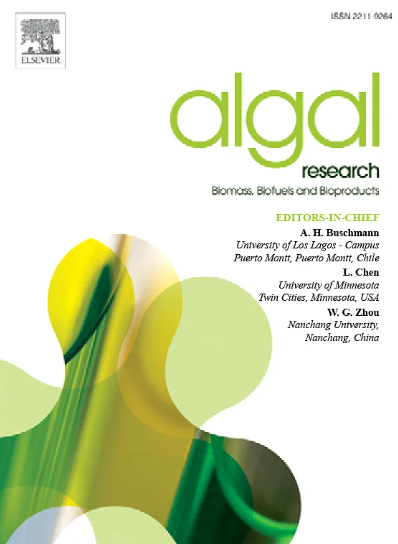A review of analytical techniques for characterizing phlorotannins in brown seaweeds: Current challenges and future prospects
IF 4.5
2区 生物学
Q1 BIOTECHNOLOGY & APPLIED MICROBIOLOGY
Algal Research-Biomass Biofuels and Bioproducts
Pub Date : 2025-05-20
DOI:10.1016/j.algal.2025.104105
引用次数: 0
Abstract
Phlorotannins, the polyphenols mostly found in brown seaweeds, have attracted high attention from the pharmaceutical industry in recent years due to their antioxidant, antibacterial, and anti-inflammatory activities. These properties make them desirable to be utilized in a wide range of therapeutics. Despite their importance, several challenges make their extractability and identification complex, for example, the unavailability of standards and their presence at low concentrations in seaweed matrices. This study reviews the analytical techniques utilized for the characterization of phlorotannins, highlights the associated challenges, and suggests potential solutions to overcome these challenges and improve the precision and reliability of phlorotannin analysis in future studies. Despite the longstanding use of conventional solid-liquid extraction (SLE) for the extraction of phlorotannin, recent studies have shifted toward more environmentally sustainable techniques. This study also highlights the critical importance of selective multi-step purification in improving the measured total phlorotannin content (TPC) and the number of identified phlorotannins by effectively removing interfering matrices, such as lipids and proteins. Nuclear magnetic resonance (NMR) and mass spectrometry (MS) have proven successful in the tentative identification of phlorotannins. However, achieving the highest level of identification confidence remains challenging due to the unavailability of standards. For quantification, the 2,4-dimethoxybenzaldehyde (DMBA) assay and quantitative NMR technique offer greater precision and specificity for phlorotannins, whereas the Folin–Ciocalteu (F![]() C) assay tends to overestimate phlorotannin content due to quantifying other phenolic compounds.
C) assay tends to overestimate phlorotannin content due to quantifying other phenolic compounds.

褐藻中褐藻单宁的分析技术综述:当前的挑战和未来的展望
褐藻单宁是一种主要存在于褐藻中的多酚类物质,因其具有抗氧化、抗菌、抗炎等活性,近年来受到制药行业的高度关注。这些特性使它们在广泛的治疗中得到应用。尽管它们很重要,但一些挑战使它们的提取和鉴定变得复杂,例如,没有标准,它们在海藻基质中的浓度很低。本研究综述了用于表征褐藻单宁的分析技术,强调了相关的挑战,并提出了潜在的解决方案,以克服这些挑战,并在未来的研究中提高褐藻单宁分析的精度和可靠性。尽管长期以来一直使用传统的固液萃取法(SLE)来提取植黑素,但最近的研究已经转向更环保的可持续技术。本研究还强调了选择性多步骤纯化的重要性,通过有效去除干扰基质,如脂质和蛋白质,提高测量的总蓝单宁含量(TPC)和鉴定的蓝单宁数量。核磁共振(NMR)和质谱(MS)已被证明成功地初步鉴定了紫丹素。然而,由于缺乏标准,实现最高水平的识别信心仍然具有挑战性。对于定量,2,4-二甲氧基苯甲醛(DMBA)测定和定量核磁共振技术提供了更高的精确度和特异性,而福林- ciocalteu (FC)测定由于定量其他酚类化合物,往往高估了苯酞的含量。
本文章由计算机程序翻译,如有差异,请以英文原文为准。
求助全文
约1分钟内获得全文
求助全文
来源期刊

Algal Research-Biomass Biofuels and Bioproducts
BIOTECHNOLOGY & APPLIED MICROBIOLOGY-
CiteScore
9.40
自引率
7.80%
发文量
332
期刊介绍:
Algal Research is an international phycology journal covering all areas of emerging technologies in algae biology, biomass production, cultivation, harvesting, extraction, bioproducts, biorefinery, engineering, and econometrics. Algae is defined to include cyanobacteria, microalgae, and protists and symbionts of interest in biotechnology. The journal publishes original research and reviews for the following scope: algal biology, including but not exclusive to: phylogeny, biodiversity, molecular traits, metabolic regulation, and genetic engineering, algal cultivation, e.g. phototrophic systems, heterotrophic systems, and mixotrophic systems, algal harvesting and extraction systems, biotechnology to convert algal biomass and components into biofuels and bioproducts, e.g., nutraceuticals, pharmaceuticals, animal feed, plastics, etc. algal products and their economic assessment
 求助内容:
求助内容: 应助结果提醒方式:
应助结果提醒方式:


